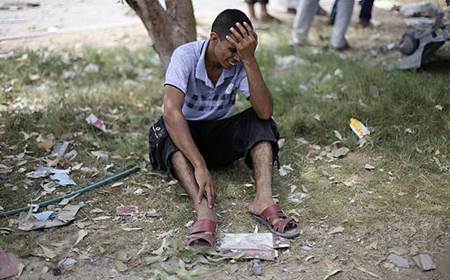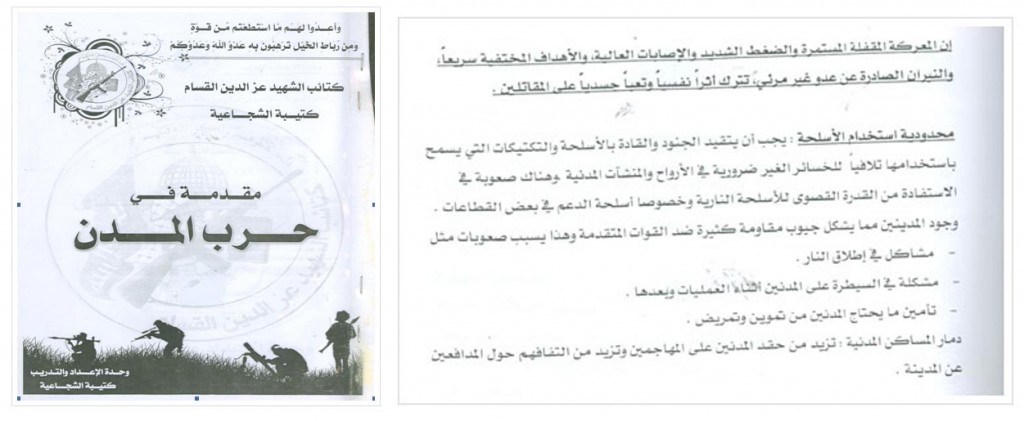http://jcpa.org/article/hamas-psychological-military-strategies-israel/
Institute for Contemporary Affairs
Founded jointly with the Wechsler Family Foundation
Vol. 14, No. 26 August 7, 2014
- Hamas, a Palestinian Islamist resistance organization, openly states that it is committed to Israel’s elimination.
- While militarily limited, Hamas employs functional psychological strategies to weaken Israel and to enlist the support of others to strengthen its own status and maintain its control of Gaza.
- As documented in manuals used by Hamas fighters, Palestinian civilian casualties and property destruction are tolerable for Hamas because they serve to engender support for their fighters. This can result in pressure on Israel to cease military operations and then to negotiate cease-fire terms to Hamas’ advantage.
- Israel has been able to withstand much of Hamas’ psychological strategy of using civilian deaths to improve its military position. It is important that this strategy not succeed in providing Hamas with tangible gains through misuse of legitimate humanitarian concerns.
- Humanitarian concern for civilian non-combatants by the media, governments and NGOs is a psychological tool that allows “enabling” of Hamas behavior. Continued “enabling” impedes efforts to empower more responsible Palestinian representatives and sets the stage for Hamas’ continued willingness to sacrifice its own population in the future.
Hamas’ Goal-Directed Ideological Behavior
Behavior is ultimately functional and consistent, determined in part by the perceived gain a specific behavior produces.1 Hamas’ behavior in its confrontation with Israel is consistent with this principle, even though ideological aspects of that behavior may appear to be irrational to non-Islamist minds.
While Hamas defines itself as an Islamic “resistance” movement (Harakat il-Muquamat Islamiyah ???? ???????? ?????????) and openly seeks the elimination of Israel,2 it understands that it does not have the military capacity at present to achieve that militant goal, which is enshrined in its charter and often repeated by its leaders, preachers and supporters.3 Despite this realization, Hamas has used violence and military action when it senses potential gain that does not come at the risk of its own survival as a movement and as the sovereign in Gaza.4 As long as Hamas believes it can survive and move towards its ultimate goal without risking its control of Gaza, it will engage and attack Israel and exploit the Palestinian public in doing so. Part of Hamas’ functional psychological strategy, consistent with other Islamist movements, is to prominently feature civilians as victims of Israeli aggression5 and distort or ignore any mention of Hamas fighters killed.6 This includes issuing directives referring to all casualties as “innocent civilians” and censoring any photos of rockets fired from population centers.7
Without Gaza as a base, Hamas’ survival as an organization and as a credible force in Palestinian life is threatened. If Hamas feels military action could lead to creating conditions where it could negotiate terms advantageous to its survival and continued control of Gaza, it will engage in such action, even though it recognizes that it cannot presently “win” a traditional military campaign against Israel. Hamas has been in dire economic straits since losing critical support from past allies.8 This has placed considerable pressure on the organization, threatening its hold on rule in Gaza and providing the stimulus to attack Israel.9
The Functional Psychological Strategy
Israeli military response to Hamas attacks from Gaza — as in past attacks — created a civilian humanitarian crisis. The mechanism for creating this crisis was a ground invasion by Israel, which Hamas sought to provoke.10 An invasion also exposed the IDF to casualties and/or kidnappings which Hamas hoped would psychologically weaken Israeli resolve and increase the chances for a negotiated cease-fire on Hamas’ terms. In Hamas’ eyes, while a ground action resulted in significant damage to Gaza, it was tolerable if the terms of a cease-fire maintain Hamas’ hold on Gaza. As in previous conflicts, Hamas hoped that a perceived humanitarian crisis would lead to international pressure for capitulation to Hamas demands (e.g., the Turkey-Qatari blueprint) that ensure Hamas’ continued survival and ability to rebuild and strengthen its status.11
Thwarting the Intended Psychological Effects on Israel
The hoped-for effects of this strategy were not realized by Hamas. Israel’s “Iron Dome” anti-rocket defense effectively prevented serious civilian casualties, well-planned Israeli shelters reduced panic and fear, and despite disruption in routine in certain areas (particularly in the south), the Israeli public supported the military operation, notwithstanding the cost in military casualties.12 This broad public support upset the Hamas strategy that relied on IDF casualties to force a cease-fire. Moreover, while the attack tunnels used by Hamas were meant to instill fear and panic, the strategy appears to have backfired. While the tunnels did create public anxiety and became the major IDF target13 of the ground war Hamas desired, it appears to have increased rather than decreased Israeli public support and determination in continuing and expanding the ground offensive.
Hamas’ Creation of Co-dependent “Enabling” of its Behavior
While Israel has managed to withstand the psychological challenges to date, outside actors have not. Like an addict who psychologically draws co-dependents into “enabling” their behavior, Hamas exploited civilian casualties to ensure that others “enable” a cease-fire,14 hoping then to negotiate terms to its advantage.
Consistent with documentation in Hamas’ manual on “urban warfare”, the organization realized that civilian casualties “… increases the hatred of the citizens towards the attackers [the IDF] and increases their gathering [support] around the city defenders (resistance forces [i.e. Hamas]).15 “Enablers” who produce the support Hamas seeks include governments, mediators, the press, social media, NGOs and others who blame Israel, rather than the “addict” (Hamas), for the humanitarian crisis created by conflict.16 The knowledge that others will “enable” this behavior by using humanitarian concerns to force capitulation to Hamas demands reinforces Hamas willingness to sacrifice civilians and endure property destruction for the cause. Hamas’ own “Iron Dome” is the civilian population of Gaza. Their suffering and death serves to protect Hamas leadership and assure its continued rule in Gaza.
Hamas’ psychological motor is different from that of non-Islamist ideologies and may be difficult for Western political strategists to grasp. Consistent with Islamist strategy related to a truce (????-Hudna), cease-fires are not pauses in order to work for peace, but rather merely tactical “time-outs” until one is strong enough to once again force its agenda through war and violence.17 At that time, civilians will once again be a tool in Hamas’ arsenal and their lives once again endangered by Hamas’ willingness to sacrifice them if expedient.
Preventing a Psychology of “Enabling” Dysfunctional Behavior
Hamas will cease endangering Palestinian lives only if the psychological and functional “enabling” that allows it to use civilian deaths for its self-preservation ends.
This ultimately requires severely weakening Hamas, stripping it of any effective power and control that would allow it to rearm militarily.
Hamas’ “last shot” minutes before an agreed upon cease-fire18 reflects the mindset and intentions of a group that has not abandoned its ideology and goal of Israel’s destruction by force nor its own strategy of sacrificing its civilians towards that end. A statement by Hamas leader Ismail Haniyeh declaring “victory”19 when many of Gaza’s citizens are homeless and without basic infrastructure further demonstrates Hamas’ disregard for the onerous price paid by the civilians of Gaza.
Those in the international community who continue to enable this dangerous strategy and behavior and allow Hamas to rebuild under the pretext of humanitarian concerns bear at least some responsibility for Hamas’ future targeting of Israel’s population and for the inevitable Palestinian civilian casualties and destruction in the next round of fighting that Hamas seeks.

* * *
Notes
1 http://www.sciencedirect.com/science/article/pii/S1077722908000837
2 from Preamble to the Hamas covenant: ?Israel will exist and will continue to exist until Islam will obliterate it, just as it obliterated others before it?
3 http://avalon.law.yale.edu/20th_century/hamas.asp
4 Witness Hamas’ previous military confrontations with Israel in “Operations Cast Lead” (2008-9) and “Pillar of Defense” (2012).
5 http://www.meforum.org/1867/the-psychological-asymmetry-of-islamist-warfare
6 http://time.com/3035937/gaza-israel-hamas-palestinian-casualties/
7 http://www.memri.org/report/en/0/0/0/0/0/0/8076.htm
8 http://english.al-akhbar.com/node/17149
9 http://www.haaretz.com/news/diplomacy-defense/.premium-1.608344
11 http://www.haaretz.com/news/diplomacy-defense/.premium-1.607856
13 http://www.haaretz.com/news/diplomacy-defense/.premium-1.608762
15 http://www.idfblog.com/blog/2014/08/04/captured-hamas-combat-manual-explains-benefits-human-shields/
16 http://www.the-american-interest.com/articles/2014/08/05/the-medias-role-in-hamas-war-strategy/
17 http://www.meforum.org/1925/tactical-hudna-and-islamist-intolerance
19 http://www.ynetnews.com/articles/0,7340,L-4555418,00.html
– See more at: http://jcpa.org/article/hamas-psychological-military-strategies-israel/#sthash.0NOzdJlE.dpuf










